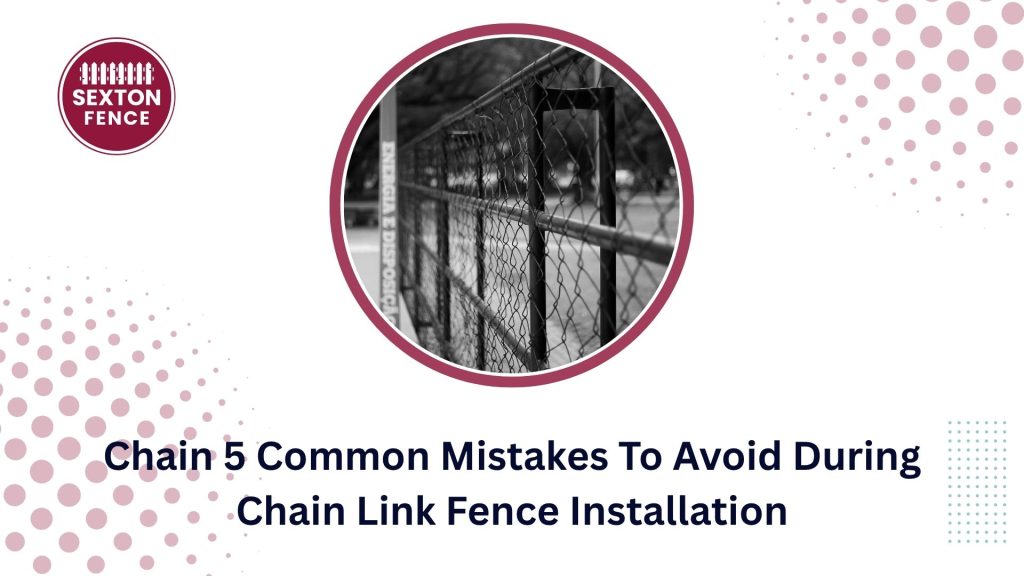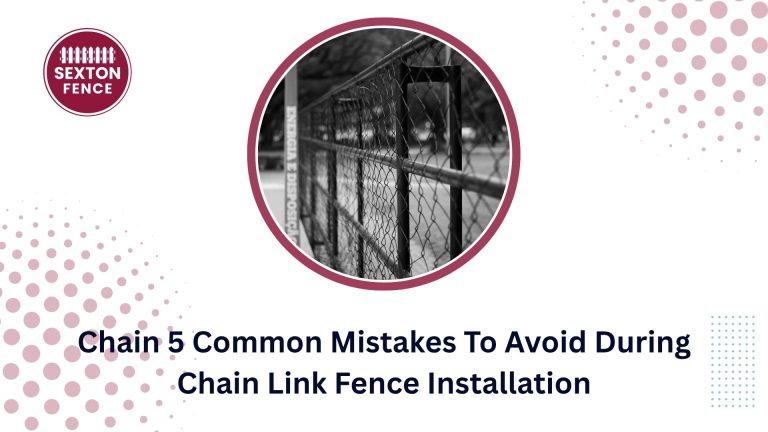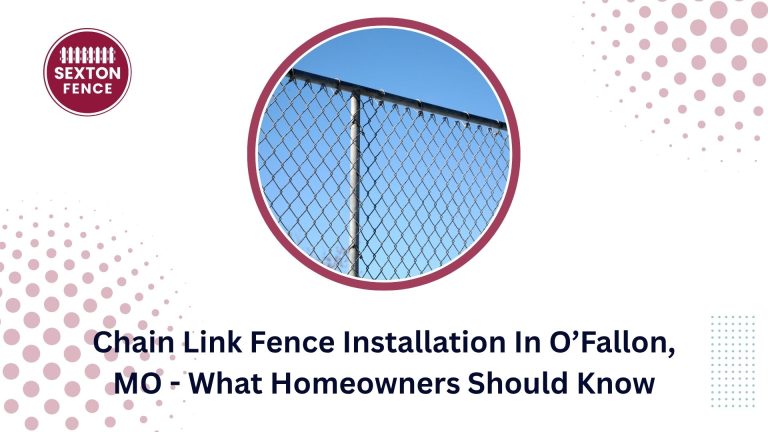Fence installation can be a rewarding DIY project, but making common mistakes can lead to costly repairs and safety issues. As you initiate on your chain link fence installation in O’Fallon, MO, it’s vital to be aware of these pitfalls that can affect your project’s success. From improper measurements to neglecting local regulations, avoiding these errors will ensure that your fence stands strong and serves its purpose effectively. Let’s explore the five mistakes you need to steer clear of for a smooth installation process.
Key Takeaways:
- Ensure proper post spacing to maintain fence stability and alignment.
- Use quality materials to avoid issues with durability and maintenance.
- Prepare the ground adequately to prevent future settling and leaning of the fence.
Understanding Chain Link Fencing
Chain link fencing consists of woven steel wire, forming a durable and versatile barrier. It is available in various heights, gauges, and coatings, making it adaptable for diverse settings, from residential yards to commercial properties. Its transparent design maintains visibility while providing security, and it can be easily customized to meet your specific needs. This type of fencing has gained popularity due to its affordability, low maintenance, and straightforward installation process.
Benefits of Chain Link Fencing
Choosing chain link fencing offers numerous advantages, such as cost-effectiveness and low maintenance requirements. Its durability ensures it withstands weather conditions and minimizes repair needs. Additionally, chain link fencing provides security while allowing for visibility, making it ideal for various applications. You can also opt for various heights and coatings to enhance aesthetics and protection against rust.
Common Uses and Applications
Chain link fencing serves multiple purposes in both residential and commercial contexts. It is commonly used for yard enclosures, playgrounds, sports fields, and industrial sites. You’ll often find it around schools and parks, providing safety and security without obstructing views. Its adaptability makes it suitable for temporary setups as well, like construction sites or event perimeters.
For residential properties, chain link fences protect pets and children while maintaining an open feel. In commercial settings, they provide security for warehouses and storage areas. Additionally, chain link fencing is often utilized in agricultural applications, fencing off livestock and crops. You’ll appreciate that it can also be topped with barbed wire for an additional layer of security in high-risk areas.
Planning and Preparation
Effective planning and preparation are foundational steps in achieving a successful chain link fence installation. This phase includes evaluating your yard layout, determining fence alignment, and arranging necessary tools and materials. Allocate time for planning to avoid last-minute decisions that could compromise the installation quality and overall appearance of your fence.
Choosing the Right Location
Identifying the optimal location for your chain link fence is crucial. Aim to position the fence within your property boundaries, ideally at least a few inches in from the edges to avoid any legal disputes with neighbors. Be mindful of any landscaping features or utilities that may interfere with the installation.
Understanding Local Regulations
Local regulations can significantly impact your chain link fence installation. Obtain information regarding property lines, height restrictions, and any required permits to ensure compliance with local codes.
Familiarize yourself with O’Fallon regulations specifically, as they often dictate the maximum height and specific materials allowed for residential fences. You might be required to submit a site plan showing the proposed fence location, and failure to comply may lead to fines or the necessity to remove the fence. Consulting the city’s zoning office or website can provide clarity and prevent complications during installation.
Proper Tools and Materials
Equipping yourself with the right tools and materials is important for a successful chain link fence installation. Inadequate or inappropriate items can lead to increased labor and potential malfunctions down the line. Ensure you have all the necessary equipment on hand before starting to avoid frustrating delays.
Essential Tools for Installation
To install a chain link fence effectively, you’ll need specific tools such as a post hole digger, a concrete mixer, a level, and a wire cutter. Each tool serves a vital function; for example, using a post hole digger ensures precise holes for setting your fence posts, which is key to maintaining alignment.
Selecting Quality Materials
Choosing quality materials is fundamental to your fence’s longevity and performance. Opt for galvanized steel wire that offers resistance against rust and corrosion. The thickness of the wire, typically ranging from 11 to 9 gauge, affects strength and durability; a thicker wire typically lasts longer and withstands environmental stress better.
Investing in superior materials can save you from frequent repairs and replacements. For example, a chain link fence constructed with 11-gauge wire could last up to 20 years with minimal maintenance, while a lower gauge may show signs of wear much sooner. When opting for, also consider additional protective coatings or powder finishes that enhance aesthetic appeal and increase longevity, ensuring your fence withstands both time and the elements effectively.
Installation Techniques
Employing correct installation techniques is vital for the longevity and performance of your chain link fence. From setting the posts to securing the fabric, each step requires attention to detail. Missteps can lead to weakening of the structure and costly repairs, so it’s imperative to follow industry best practices throughout the process.
Setting Fence Posts Correctly
To ensure stability, your fence posts must be set at least one-third of their length into the ground. For most residential fences, this means digging holes at least two feet deep and spacing the posts six to ten feet apart. Using a level to check vertical alignment throughout the process helps prevent leaning or instability.
Securing the Chain Link Fabric
Once the posts are in place, properly securing the chain link fabric is fundamental. Use tension bands and rails to attach the fabric to each post. Ensure the fabric is taut to avoid sagging, which can compromise both aesthetics and structural integrity.
When securing the chain link fabric, start by unrolling it along the fence line, ensuring it’s extended tight and even. Fasten it to the top rail using tie wires spaced every few feet, as this reinforces the fabric against wind and movement. Importantly, when cutting the fabric, maintain a straight edge to facilitate clean connections to the posts. Properly layered fabric and secure ties help thwart rust accumulation and sagging, ensuring longevity and visual appeal for your chain link fence.
Common Installation Mistakes
During chain link fence installation, being mindful of common mistakes can save you time and money. Neglecting these pitfalls often leads to costly repairs and adjustments. For guidance on avoiding mistakes, check out How to Avoid Common Mistakes When Making a Chain ….
Ignoring Local Terrain
Not taking local terrain into account can significantly impact your fence’s stability and alignment. Uneven ground may result in warping or gaps, making your fence less effective and visually appealing. Before installation, assess the landscape and adjust your plans accordingly to ensure a level and properly anchored fence.
Failing to Check for Utility Lines
Ignoring utility lines can lead to serious hazards during installation. Before digging, it’s imperative to contact local utility companies to mark any underground lines, which could include water, gas, or electric services. Not doing this could result in damaging these lines, endangering yourself and others, and incurring costly repairs.
In O’Fallon, MO, failing to check for utility lines can have dire consequences. Many homeowners receive hefty fines or face liabilities after accidentally severing a line during installation. Marking utility paths helps prevent dangerous accidents, as some lines may be buried just below the surface. Secure your installation by always performing a utility check, ensuring safety and compliance with local regulations.
Maintenance Tips
To ensure the longevity of your chain link fence in O’Fallon, MO, consistent maintenance is crucial. A well-maintained fence not only enhances curb appeal but also prevents costly repairs. Follow these tips:
- Inspect for rust and corrosion.
- Clean debris regularly.
- Adjust tension wires as needed.
- Check for loose fittings.
Perceiving minor issues early can save you time and money in the long run.
Regular Inspections
Conducting regular inspections is vital for the health of your chain link fence. Aim for at least twice a year checks to spot rust, bent poles, or loose connections. Catching problems early allows you to take the necessary steps before they escalate into significant repairs.
Repairing Damage Promptly
Addressing any damage immediately keeps your chain link fence functioning optimally. Small issues like loose wires or rust spots can develop into bigger problems, threatening both the structure and security of your property.
When you notice a flaw, gather the right materials and tools for repair, such as rust-resistant paint and replacement parts. For instance, if you find a rust spot, sand the affected area, apply a rust-inhibiting primer, and repaint it. Doing so will not only enhance durability but also maintain the visual appeal of your chain link fence. Keeping a proactive approach to repairs ensures the fence remains strong and protects your property effectively.
Final Words
Avoiding common mistakes during your chain link fence installation in O’Fallon, MO can save you time, money, and unnecessary frustration. Proper planning, accurate measurements, and attention to detail—along with high-quality materials—are essential for a strong and long-lasting fence. Always check local regulations, prepare your site thoroughly, and never overlook the importance of correct post placement and secure fabric tensioning. By taking a careful, step-by-step approach, you can ensure your fence performs well for years to come while enhancing both the safety and appearance of your property.
For homeowners who prefer a professional touch, Sexton Fence provides expert chain link fence installation in O’Fallon, MO. Our experienced team handles every phase of the process—from planning and permitting to installation and finishing touches—with precision and care. We specialize in galvanized and vinyl-coated chain link fences built for strength, style, and longevity. Whether you’re securing your home, business, or recreational area, Sexton Fence delivers trusted results backed by exceptional service.
Contact Sexton Fence today for a free estimate and see why we’re O’Fallon’s go-to fence installation experts.




